It was the second Tuesday in November 2004, and as always on election day I did my civic duty by passing on the morningxe2x80x99s hunt and voted. Since it was right on the cusp between the pre-rut and main rut, however, I wasnxe2x80x99t about to miss the entire day, and after voting I drove 2xc2xbd hours south to hunt the midday/evening shift on a 20-acre parcel that I had permission on.
While only 20 acres, it was comprised of two bedding areas with a narrow 50-yard pinch point of transition security cover dead center between them, and the only two apple trees in the entire area were dead center in the funnel.
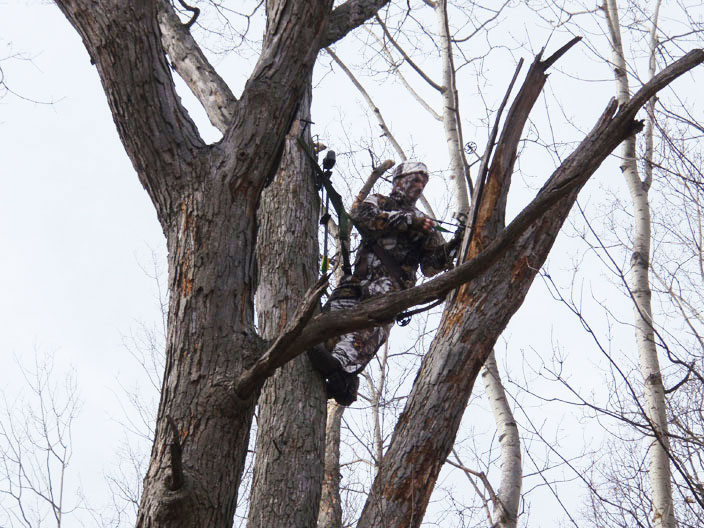
The surrounding area was relatively open and not conducive to daytime mature buck movements, plus to top it off, I could access the pinch point from the side without intruding through the bedding areas. I knew there was a bruiser working the area by the signpost rubs that I saw on an earlier hunt.
By 12:30 p.m. I was perched in my saddle about 15 yards downwind of several active scrapes that were beneath the nearest apple tree. In one of the scrapes I noticed a small area of wet dirt, which meant a deer had recently urinated in it, and since the scrape had also been worked, I assumed it was by the buck that had been leaving rubs 3 to 4 feet high on the nearby trees.
At 1:35 p.m. a small 8-point buck came in downwind from the south to check the scrapes, and as he approached his body posture was very timid and extremely cautious. As if he was intruding in another buckxe2x80x99s territory, he went right under my tree and slowly worked his way to the scrapes. From several yards downwind, he did his best to rubber neck and scent-check the previous buckxe2x80x99s urine. Then, as if he had dealt with that buck before and lost, he wheeled and ran back from where he had come from.
It wasnxe2x80x99t 20 minutes later that the dominant buck that had been aggressively signposting the area came into view from the bedding area to the north. Common with midday mature buck movements during the rut phases, as if caution had been abandoned, he was steadily moving on a mission.
Instead of coming directly into the slightly open scrape area, he circled the edge of the security cover to the east. I had a shooting lane there, but by the time that I realized he was not coming to the scrapes and I swung 180 degrees to the opposite side of the tree, his rapid pace had walked him right through it.
As he circled to get downwind, I slowly swung 180 degrees back to my original position on the south side of the tree. At about 30 yards directly downwind he turned and moved in until he was standing at the base of my tree, which is where he finally stopped. Standing there, he slightly raised his head to test the air with a lip curl.
I had a straight down opportunity, which is a simple shot to make from a saddle, but itxe2x80x99s unethical, so I passed. If he moved in and worked a scrape all I would have to do is lean slightly to my left and take the shot, but no such luck.
At this point, no matter which way he went I could move into position for a shot, so I just waited for his next move. I properly care for and use ScentLok clothing, so having him smell where I had stood at the base of the tree or wind me from downwind was never a concern.
Once satisfied that nothing of a sexual interest had entered the scrape area since he urinated in it earlier, he turned and began circling back in the exact footsteps that he came in from. I swung 180 degrees back around the tree to ready myself on the shooting lane that he previously passed through. As his black snout entered it I came to full draw, and as soon as his chest cleared the brush, I performed a vocal doe bleat to stop his rapid pace.
I released my arrow and watched as it disappeared behind his front shoulder. He took off at full throttle and I watched him expire within sight.
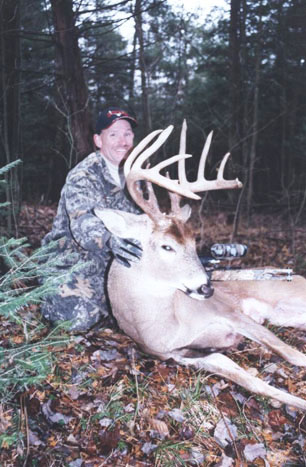
Have you ever experienced a hunting situation when you couldnxe2x80x99t get a shot because the deer was on the backside of the tree you had your stand in? If youxe2x80x99ve been hunting very long from any form of conventional platform stand, youxe2x80x99ve likely lost shot opportunities due to areas around the tree that you couldnxe2x80x99t shoot to.
While hang-ons, climbers and ladder stands are conventional methods of ambush hunting that every deer hunter is familiar and comfortable with, there is another secret weapon for ambush hunting that not many hunters have heard of, or have been reluctant to try because it is so different.
Itxe2x80x99s common knowledge that deer donxe2x80x99t always come in from where you want, and thatxe2x80x99s especially true during the rut phases when bucks pursue does on uncharted routes. Itxe2x80x99s also common knowledge to those hunting in pressured areas, that the likelihood of receiving a second opportunity at a mature buck after the first opportunity has been squandered, is extremely rare.
So how do you guarantee the ability to take advantage of every shot opportunity, no matter where around the tree it presents itself? The answer is simple, but will require a change in your current thought process of treestand use.
Welcome to the exploding world of xe2x80x9csaddlexe2x80x9d hunting.
History of Saddle Hunting
Hunting slings and saddles have been around since the early 1980s, and I purchased an Anderson Treesling in 1981 and have exclusively (unless hunting from the ground) hunted from it since. Ixe2x80x99ve never looked back into the rearview mirror of hunting from noisy and cumbersome metal stands. In fact, 27 of my 31 Michigan record book bucks and all 19 of my out-of-state Pope & Young bucks have been taken from that original sling/saddle.
Several other companies have offered saddles with different features and designs. James Green introduced his Trophyline saddle in the xe2x80x9880s, and the saddle name stuck and is now what all harness-style versions are referred to.
In June of 2018 Greg Godfrey and Ernie Powers began Tethrd Nation (www.tethrdnation.com) and introduced the Mantis saddle. The Mantis weighs in at just over 1 pound, and in my opinion is the most compact, mobile and user-friendly saddle ever commercially made.
I donxe2x80x99t think that I need to spend any time explaining how conventional metal hang-on stands, climbing stands or ladder stands work because every hunter is familiar with them. So Ixe2x80x99m going to go over what a saddle is, how theyxe2x80x99re used and their many advantages over conventional stands.
What is a Saddle?
Ever watch a telephone utility worker hanging from a telephone pole or an arborist working in a tree? Well if you have, the harnesses that they wear while tethered to the pole or tree are the same general concept as a saddle for hunting. Saddles are made of fabric and the linemanxe2x80x99s belt and tree tethers are made of either ropes or nylon straps.
With a saddle you use the same climbing apparatuses (sticks or steps) as you would with hang-on stands, and when hunting youxe2x80x99re comfortably sitting in a hammock-like fabric seat that is tethered to the tree in front of you. The tree tether has adjustment capabilities to quickly change how youxe2x80x99re seated at any time during a hunt.
While hunting, your feet rest on tree steps placed around the tree or on a lightweight Tethrd Nation Predator platform. Additional steps can be placed around the tree that will allow you to move around the tree and shoot in every direction. Thatxe2x80x99s the general concept.
20 Advantages of Hunting From a Saddle
1. Safety: While thousands of hunters have fallen from conventional stands when stepping on or off of them, when properly hunting from a saddle you are tethered to the tree from the moment you leave the ground until you step back on it after the hunt xe2x80x94 so you canxe2x80x99t fall. Saddles are the safest systems for hunting from trees.
2. With saddles there is no noise associated with pulling up stands, setting them up or using a noisy climbing stand on a rough-barked tree.
3. With saddles there are no metal joints or platforms to make creaking noises at crunch time when you have to shift your weight for a shot.
4. Depending on the style, complete saddle systems weigh anywhere from 1xc2xbd to 4 pounds, and easily fit in any backpack with other layering garments and hunting gear, or they can be worn while walking and are barely noticeable.
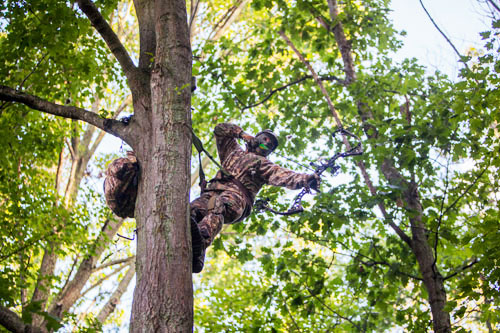
5. With a saddle you have 360-degree shooting mobility around any tree, so there are no missed opportunities like there are with conventional stands with limited shooting mobility to the backside of large trees. During the rut phases when bucks chase does on unpredictable routes, being able to take advantage of every opportunity is a huge deal.
6. One of the biggest advantages of a saddle is that at destination locations such as fruit and mast trees, or at scrape areas where itxe2x80x99s common to have multiple deer standing and lingering for several minutes at a time, is the mobility of being tethered on the opposite side of the tree trunk from the destination site. This will keep you hidden from the deer that are lingering and looking around while eating or working a scrape.
With a saddle you always want to keep the tree trunk between you and the deer you may or may not want to shoot. When you want to shoot, the mobility of the saddle allows you to swing slightly to the side and make the shot. This huge advantage eliminates the hunterxe2x80x99s profile from sticking out to the side of the tree and the chance of being seen. This frequently happens with conventional stands because you have no option but to set up somewhat on the side of the tree because you canxe2x80x99t shoot to the destination site from the opposite side of most trees.
7. With a saddle you are able to hunt large and small diameter trees, whereas with conventional hang-ons and climber stands, trees must be a specific size to accommodate them. Ixe2x80x99ve taken bucks from trees that were 4 inches in diameter and from trees that were over 30 inches in diameter.
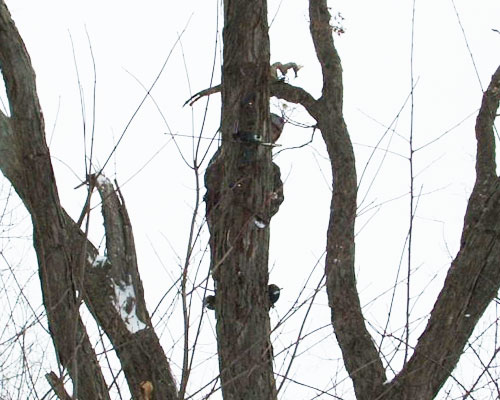
8. Unlike when using a climber, trees donxe2x80x99t have to be telephone poles and devoid of branches in order to hunt from them. Branches and tree crotches can actually be used as steps and additional concealment cover.
9. With a saddle, trees leaning up to 15 degrees and oddly shaped trees can be hunted from comfortably.
10. Unlike standing and shooting from a conventional stand, when shooting from a saddle you always have three solid points of body contact with both feet on steps or a Predator platform and your upper body weight securely supported by the seat. Three points of body contact gives you a solid and comfortable base when shooting, which will equate to better accuracy.
11. With a saddle you can have as many pre-set locations prepared as desired while owning only one saddle to hunt from all of them. Having many pre-set location options and rotating them increases the element of surprise and decreases the human intrusions and contamination of each site. Since your saddle is always with you, you simply hunt the locations when and where the sign is hot.
12. With conventional stands, you need one for each pre-set location, otherwise you would have to carry a heavy and cumbersome stand along with your pack and bow to each spot and then make the noise of setting it up. Just imagine having to purchase conventional stands for 20 or more locations. The cost would be astronomical, and even then the hunter wouldnxe2x80x99t have all of the other advantages of using a saddle.
13. With a saddle you never have to worry about stolen stands because the saddle is always with you. On public land and in heavily pressured private areas treestand theft is a major issue.
14. With a saddle other hunters canxe2x80x99t hunt your location because your saddle isnxe2x80x99t in the tree, itxe2x80x99s with you.
15. When using a saddle on public and free-permission properties where there are other hunters you donxe2x80x99t know, youxe2x80x99re not leaving the visual sign of a stand in a tree for other hunters to notice and set up next to. Saddle setups are very difficult to see.
16. Saddles are extremely comfortable to sit in on all-day hunts. On average nearly 60 percent of record book bucks from every state are taken during the short rut phase periods, and the ability to sit all day during those times is a huge advantage. Saddles have drape adjustments so that you can adjust your seating position within seconds, adding to the overall comfort for long sits.
17. With a saddle, your upper body is not constricted within a shoulder-style safety harness or vest thatxe2x80x99s tethered to the tree behind you like when safely hunting from conventional stands. When utilizing a saddle your upper body is not encumbered with straps and you can easily add or remove upper body layering garments to allow for changing weather conditions.
18. A saddle also doubles as a climbing harness for safely preparing trees. By using only the adjustable lineman safety rope, you can have both hands free for placing steps or sticks and cutting branches when preparing trees.
19. Saddles are perfect for freelance hunting since they are in your pack or youxe2x80x99re wearing it. A fanny pack loaded with steps can be worn below your backpack for mobile freelance hunting. When freelancing in pressured areas, hunters donxe2x80x99t have the luxury of walking on trails or through open timber as seen on TV, they have to transition through thick cover where toting cumbersome stands and sticks would not be very feasible.
If freelance hunting, conventional hang-on stand users would also need to carry a safety climbing harness for installing their steps and stand so they could have both hands free. With the lineman rope a saddle doubles as a safety climbing harness.
20. With the versatility of the saddle for different tree diameters and leans, the saddle is perfect for finding a good location and making a tree work within shooting distance of the best deer sign.
With conventional stands itxe2x80x99s common not to have a suitable tree at the destination site and have to set up away from farther away from locations such as mast or fruit trees, scrape areas or pinch points. This often places some of the best deer trails leading to the destination sites out of range xe2x80x94 and possibly out of sight.
Saddle hunting is a concept that flies against the grain of conventional treestand manufacturers that want to sell hunters a stand for every one of their hunting locations. Saddle hunting also flies against the TMA (Treestand Manufacturers Association) as they are controlled by treestand manufacturers.
Saddle Hunting Experience
Ixe2x80x99m quite positive that no other hunter has spent more hours perched in a saddle-style harness system than me. Ixe2x80x99ve exclusively hunted from a saddle since 1981 when hunting from trees xe2x80x94 thatxe2x80x99s 37 seasons of saddle hunting.
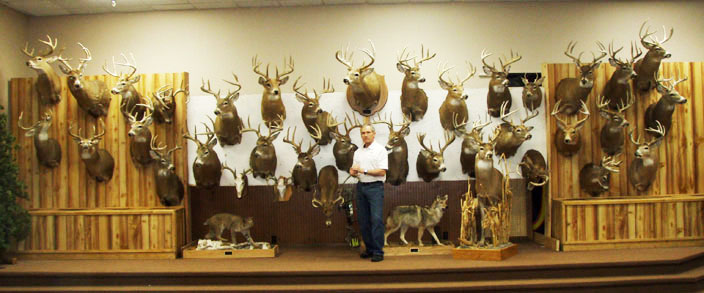
Out of my 50 record-class bucks, 44 of them were taken with a bow from my original and modified saddle, and I attribute many of them to the aforementioned advantages of hunting from a saddle. There is absolutely NO WAY that I would have taken many of those 44 bucks from any type of conventional stands due to their limitations.
Editorxe2x80x99s note: John Eberhart has an accumulative total of 50 record book bucks (31 from Michigan and 19 out of state) from 32 different properties. John also runs Eberhartxe2x80x99s Whitetail Workshops (two-day events), has co-authored three bowhunting books and produced the instructional DVD series xe2x80x9cBowhunting Pressured Whitetailsxe2x80x9d. For more information please visit: www.deer-john.net.
